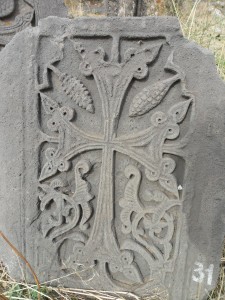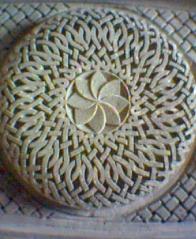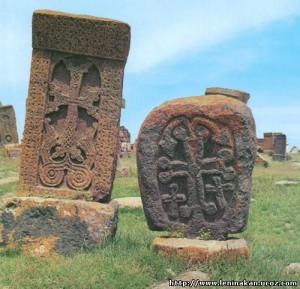All News
geghard
Cross-stones
 In 2010 Armenian cr oss-stone art was included in UNESCO intangible cultural heritage list.In every culture there is a distinctive element which is not found anywhere else, and which becmes a symbol of the entire national culture. In Armenia, this symbol is the “khachkar” – the so-called cross-stone – typical and unique monuments of Armenian culture. The word “cross-stone” is formed by two Armenian roots: “Khach” – cross and “kar” – stone. Khachkars represent a special kind of art – decorative and architectural sculpture, based on ancient national traditions and of diversity and richness of forms.hachkars were carved at the beginning of IV century, soon after Armenia adopted Christianity. Instead of the pagan altars, and in places where in the future were to be erected churches and monasteries, installed wooden crosses. But wood is short-lived, so they began to replace wood with stone, and from the IX century – a cross on a rectangular stone plates. Then cross-stones were mounted on various occasions:
In 2010 Armenian cr oss-stone art was included in UNESCO intangible cultural heritage list.In every culture there is a distinctive element which is not found anywhere else, and which becmes a symbol of the entire national culture. In Armenia, this symbol is the “khachkar” – the so-called cross-stone – typical and unique monuments of Armenian culture. The word “cross-stone” is formed by two Armenian roots: “Khach” – cross and “kar” – stone. Khachkars represent a special kind of art – decorative and architectural sculpture, based on ancient national traditions and of diversity and richness of forms.hachkars were carved at the beginning of IV century, soon after Armenia adopted Christianity. Instead of the pagan altars, and in places where in the future were to be erected churches and monasteries, installed wooden crosses. But wood is short-lived, so they began to replace wood with stone, and from the IX century – a cross on a rectangular stone plates. Then cross-stones were mounted on various occasions: to commemorate a victory over the enemies, on the occasion of completion of construction of a temple or a bridge, in gratitude for getting a land allotment, etc. Cross-stones served also as boundary marks, and very often as tombstones. In khachkars there is the spirit of the Armenian people and the theology of the Armenian Apostolic Church. It is quite natural that the art of Armenian khachkar is compared only with another magnificent phenomenon of the Armenian medieval art, that of Armenian miniature. Exceptionally valuable specimens of khachkars are to be found in various parts of Kotayk Marz of Armenia.
to commemorate a victory over the enemies, on the occasion of completion of construction of a temple or a bridge, in gratitude for getting a land allotment, etc. Cross-stones served also as boundary marks, and very often as tombstones. In khachkars there is the spirit of the Armenian people and the theology of the Armenian Apostolic Church. It is quite natural that the art of Armenian khachkar is compared only with another magnificent phenomenon of the Armenian medieval art, that of Armenian miniature. Exceptionally valuable specimens of khachkars are to be found in various parts of Kotayk Marz of Armenia.



